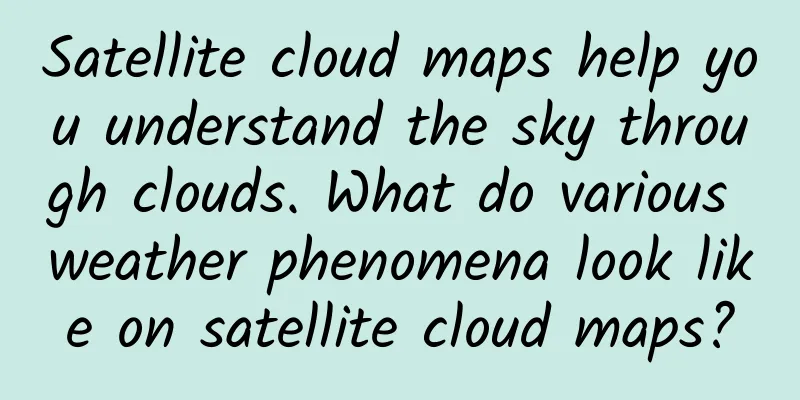Satellite cloud maps help you understand the sky through clouds. What do various weather phenomena look like on satellite cloud maps?

|
Clouds are like a "signboard" for the weather. There is an old saying that one can tell the weather by looking at the clouds! But it is already 2024! Meteorological experts have already prepared satellite cloud maps to help you decipher the weather! Let's take a look! | What is satellite cloud imagery? Satellites are like cameras hanging high in the sky. "Satellite cloud images" are photos taken by meteorological satellites from top to bottom of the area you are interested in. In the photos, you can see the clouds covering the earth and the surface features. Finally, the photos are sent to the receiving device on the ground, which will interpret and process the photos to get the image we want! Compared with the traditional meaning of "looking at the clouds to know the weather", satellite cloud images will show you more aspects of the weather because they "stand" higher and farther. | Do all satellite cloud images look the same? Do all satellite cloud images look the same? Of course not! Satellite cloud images are divided into three categories according to the differences in the receiving bands of satellite sensors. There are three commonly used categories: visible light cloud images, water vapor cloud images, and infrared cloud images . They all have their own appearances! Visible light cloud images are made by using the principle of sunlight reflected from the cloud tops, so they can only be taken during the day. The resulting cloud images are similar to the color photos we take with our phones and cameras. Therefore, from the images of visible light cloud images, we can easily distinguish that white is clouds, dark blue is the ocean, green and gray-brown are land... The scene we see is very intuitive, so it is the most widely used. The water vapor cloud map is an image that is generated by satellites receiving radiation emitted by water vapor in the atmosphere and displayed in black and white tones. The more water vapor there is in the atmosphere, the less radiation is emitted, and the whiter the tone on the water vapor map is, and vice versa. It is like a "black and white photo" that reflects the amount of water vapor in the clouds. Similar to the water vapor cloud map, the infrared cloud map is an image of infrared radiation emitted by the surface and clouds measured by satellites, and is also displayed in black and white. Here, the radiation received by the satellite is only related to the temperature. The lower the temperature, the less radiation, and the whiter the tone in the cloud map. Conversely, the image in the high temperature area is darker. It is also a "black and white photo", but it reflects the temperature characteristics of the surface and cloud tops. Since infrared remote sensing can sense and feedback cloud imagery day and night and to ground stations, it supplements a large amount of information that visible light cloud maps cannot obtain at night. After seeing so many satellite cloud images, some friends may wonder how to distinguish the many weather phenomena in nature on satellite cloud images? What should we do if we still can't understand satellite cloud images? Taking typhoons as an example, satellite cloud images are the most common means of monitoring typhoons. According to the real-time satellite monitoring images, the entire process of typhoon formation and development can be clearly monitored, and the current structural state of the typhoon can also be observed. For example, at 10:15 on August 10, 2023, Typhoon No. 6 "Kano" landed in South Korea. By comparing the visible light cloud map and water vapor cloud map above Jilin Province, it was found that: on the visible light cloud map, although the western part of Jilin Province is also covered by clouds (mixed clouds), the color of this area is darker on the water vapor cloud map, the water vapor content is low, and the precipitation trend is weak. The outer cloud belt of the typhoon above the eastern region shows a large white area on the water vapor cloud map, indicating that the water vapor content is very abundant, so large-scale rainfall weather is prone to occur in the eastern part of Jilin Province. In addition to comparing and analyzing a variety of satellite cloud images, meteorological experts also need to combine real-time information, forecast models and accumulated experience to comprehensively judge weather conditions. In order to make satellite cloud images more intuitive, experts will also perform secondary processing on satellite cloud images and obtain quantitative extraction products through model algorithms, so that even if you can't read satellite cloud images, you can also become an expert in "cloud" recognition! Editor | Wu Yujie Liu Min Proofreader | Tang Xiaoling Author's Unit | Jilin Meteorological Science Institute |
<<: Quantum bowling: a fascinating collision of the microscopic world
>>: Q: How many steps are required for an astronaut to complete a space walk?
Recommend
Another virus that infects humans and animals has been discovered. Can it be transmitted from person to person?
Recently, Professor Liu Wei, Professor Fang Liqun...
Is walking and stopping more effective in losing weight than walking all the time? | Technology Weekly
Compiled by Zhou Shuyi and Wang Xiang Ten years a...
A quick guide from C++ to Objective-C
When I started writing code for iOS, I realized t...
How can SaaS companies reduce user churn?
Reducing customer churn is a proven way for SaaS ...
JATO Dynamics: Global car sales in March 2020 totaled 5.55 million units, down 39% year-on-year
According to data from automotive data analysis c...
Apple's successes and failures in 2015
[Abstract] In 2015, Apple's smartphone profit...
Want to become a high-level SEM promotion and marketing expert? You must go through these 5 stages
The author divides bidders into 5 levels: 1. Novi...
APP developers, 4 major changes seen at Apple WWDC
Apple's annual Worldwide Developers Conferenc...
Rowhammer vulnerability: After PCs are affected, Android devices are also vulnerable
[[175834]] Previously, the Rowhammer hardware vul...
If you have these 5 daily necessities at home, it is recommended to throw them away immediately
One minute with the doctor, the postures are cons...
Is radiation in daily life harmful to the human body?
Radiation is always a concern. But in fact, it is...
Self-propagation: How to get users to voluntarily forward and recommend your products?
If your product is a C-end product, then you will...
Baidu MTC debuts at MDCC conference to help developers improve application quality
From October 14 to 16, the Mobile Developers Conf...
How to use Alipay’s money-making red envelopes?
A few days ago, I pushed some tips on how to get ...
Will eating too much solid calcium cause kidney stones? The main cause of kidney stones is...
Author: Li Jie, attending physician, Department o...









